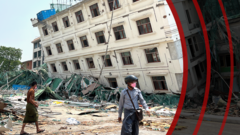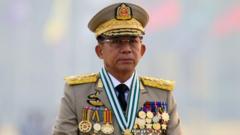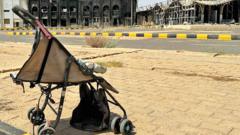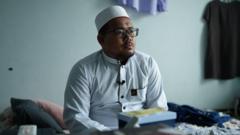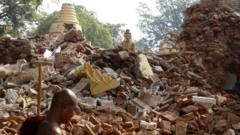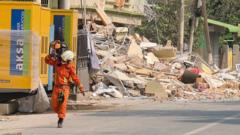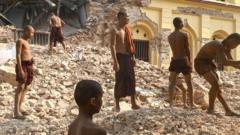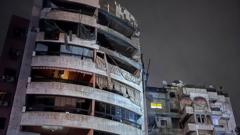Following a catastrophic earthquake in Myanmar, military authorities have hindered aid efforts as part of a strategy to control assistance provided to various regions, putting thousands in dire need at risk.
Aid Misused as a Tool in Myanmar’s Earthquake Aftermath
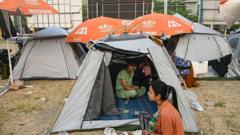
Aid Misused as a Tool in Myanmar’s Earthquake Aftermath
The military junta in Myanmar obstructs humanitarian aid following a devastating earthquake, revealing a pattern of weaponizing assistance against resistance-held regions.
In the aftermath of a catastrophic 7.7 magnitude earthquake that struck Myanmar, emergency response efforts are being severely hampered by military authorities. The earthquake, which occurred on March 28, tragically resulted in the lives of more than 2,700 individuals. Rescue and aid workers encountered immense challenges gaining access to some of the most affected areas due to military-imposed restrictions.
"After a disaster like this, there’s a crucial 72-hour 'golden window' for effective rescue operations," stated John Quinley, an international human rights group director. "However, military curfews and extensive checkpoints have complicated access, despite the junta leader Min Aung Hlaing's call for international aid."
While the junta claims to be open to assistance, reports indicate otherwise. Aid workers had their paths obstructed and faced intense scrutiny at checkpoints. They described delays and bureaucratic hurdles that only served to slow down life-saving efforts.
As the situation developed, reports surfaced of a military attack on a Chinese Red Cross aid convoy near Mandalay, illustrating the junta's violent stance toward humanitarian missions. This is not an isolated incident; historically, the military has weaponized aid by controlling which regions receive assistance, primarily favoring areas under its direct governance.
The military's actions have drawn sharp criticism from human rights advocates who point to a troubling trend during crises. These include previous natural disasters, where the junta has deliberately hindered relief efforts in areas held by resistance groups. James Rodehaver from the UN's Office for Human Rights suggested this strategy serves as punishment for populations less supportive of the junta's regime.
In regions like Sagaing, where resistance forces prevail, residents face acute shortages of food and basic necessities. Local volunteers have been forced into precarious conditions to deliver aid covertly, often needing special authorization from military officials, which is typically enforced through convoluted processes designed to stifle their efforts.
Meanwhile, some aid groups manage to operate discreetly, avoiding military checkpoints and providing essential support without attracting undue attention. However, such covert operations come with delays that can jeopardize the timely distribution of necessary supplies.
Despite the junta's initial reluctance to allow a free flow of humanitarian assistance, international pressure post-earthquake could lead to changes. Humanitarian experts express cautious optimism that the scale of this disaster could prompt the junta to relax its restrictions.
However, skepticism looms in light of the military's recent actions, including airstrikes on earthquake-affected areas, which further complicate the already dire humanitarian landscape. Observers urge vigilance in monitoring whether relief efforts genuinely reach those in need or if they are misappropriated by the junta.
As the situation continues to unfold, the battle for aid access in Myanmar remains critical, with thousands facing uncertain futures amidst political unrest and natural disaster.
"After a disaster like this, there’s a crucial 72-hour 'golden window' for effective rescue operations," stated John Quinley, an international human rights group director. "However, military curfews and extensive checkpoints have complicated access, despite the junta leader Min Aung Hlaing's call for international aid."
While the junta claims to be open to assistance, reports indicate otherwise. Aid workers had their paths obstructed and faced intense scrutiny at checkpoints. They described delays and bureaucratic hurdles that only served to slow down life-saving efforts.
As the situation developed, reports surfaced of a military attack on a Chinese Red Cross aid convoy near Mandalay, illustrating the junta's violent stance toward humanitarian missions. This is not an isolated incident; historically, the military has weaponized aid by controlling which regions receive assistance, primarily favoring areas under its direct governance.
The military's actions have drawn sharp criticism from human rights advocates who point to a troubling trend during crises. These include previous natural disasters, where the junta has deliberately hindered relief efforts in areas held by resistance groups. James Rodehaver from the UN's Office for Human Rights suggested this strategy serves as punishment for populations less supportive of the junta's regime.
In regions like Sagaing, where resistance forces prevail, residents face acute shortages of food and basic necessities. Local volunteers have been forced into precarious conditions to deliver aid covertly, often needing special authorization from military officials, which is typically enforced through convoluted processes designed to stifle their efforts.
Meanwhile, some aid groups manage to operate discreetly, avoiding military checkpoints and providing essential support without attracting undue attention. However, such covert operations come with delays that can jeopardize the timely distribution of necessary supplies.
Despite the junta's initial reluctance to allow a free flow of humanitarian assistance, international pressure post-earthquake could lead to changes. Humanitarian experts express cautious optimism that the scale of this disaster could prompt the junta to relax its restrictions.
However, skepticism looms in light of the military's recent actions, including airstrikes on earthquake-affected areas, which further complicate the already dire humanitarian landscape. Observers urge vigilance in monitoring whether relief efforts genuinely reach those in need or if they are misappropriated by the junta.
As the situation continues to unfold, the battle for aid access in Myanmar remains critical, with thousands facing uncertain futures amidst political unrest and natural disaster.

